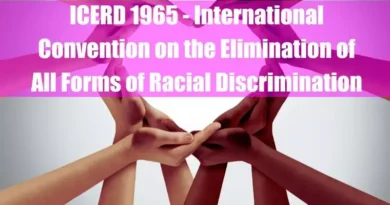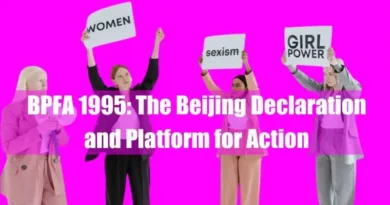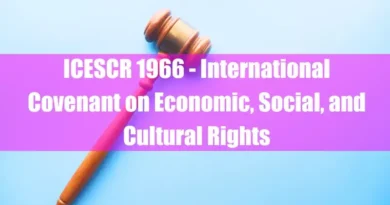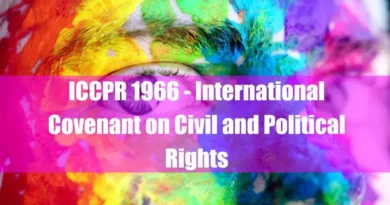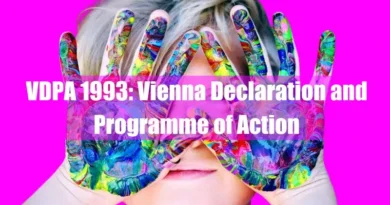I. Introduction
The Universal Declaration of Human Rights (UDHR) is a historical landmark. Adopted in 1948 by the United Nations General Assembly, this document represents a powerful and enduring vision for a world where everyone is cherished and protected. Emerging from World War II, the UDHR sought to establish a universal moral code and a shared set of values to prevent such atrocities from happening again.
A. The UDHR: A Beacon of Hope in a Dark Time
Emerging from the ashes of World War II’s atrocities, the UDHR stands as a powerful testament to the global yearning for a better future. Drafted by a diverse group seeking universal principles, it became the first document outlining fundamental rights for all, regardless of background. This included civil and political liberties, like free speech and fair trials, and economic, social, and cultural rights, like education and a decent standard of living.
B. A Foundation for Progress, Not a Finished Product
The UDHR may not be a legally binding treaty, but its moral force is undeniable. It has been a bedrock for numerous human rights treaties and national constitutions. While challenges remain, the UDHR inspires activists and guides governments toward a world where human dignity and fundamental rights are ideals and a lived reality for everyone.
II. Core Principles of the UDHR
The UDHR is founded on two core principles: universality, non-discrimination, and inalienable rights. These principles are essential for understanding the document’s scope and significance.
A. Universality and Non-Discrimination (Article 2)
Imagine a world where human rights are like exclusive club memberships, only available to a select few. The UDHR shatters this notion. Article 2 of the declaration proclaims that “everyone is entitled to all the rights and freedoms outlined in this Declaration, without distinction of any kind, such as race, color, sex, language, religion, political or another opinion, national or social origin, property, birth or another status.” This principle of universality is revolutionary. This means that human rights are not privileges bestowed by governments but inherent entitlements that belong to every single person on Earth.
1. Universality: Rights for All, Everywhere
If you were born in a wealthy nation with a long history of democracy, you might take certain rights for granted, like the right to free speech or the right to vote. However, the UDHR reminds us these rights are not just for the fortunate few. They belong equally to everyone, regardless of their background or circumstances.
2. Non-Discrimination: Equality and Respect for All
The principle of non-discrimination is equally essential. It forbids discrimination based on any factor, ensuring that everyone has the same chance to enjoy their human rights. This means that a person’s race, gender, religion, or any other status cannot be used to justify denying them their fundamental rights.
Also, read:
- VDPA 1993: Vienna Declaration and Programme of Action
- ICCPR 1966 – International Covenant on Civil and Political Rights
- ICESCR 1966 – International Covenant on Economic, Social, and Cultural Rights
- ICERD 1965 – International Convention on the Elimination of All Forms of Racial Discrimination
B. Inalienable Rights (Article 3)
The UDHR goes beyond simply listing rights. It emphasizes that these rights are inalienable and cannot be taken away. Article 3 states that “everyone has the right to life, liberty and security of person.” These fundamental rights are inherent to our humanity, and no government or other entity has the authority to strip them away.
1. The Concept of Inalienable Rights: Intrinsic and Untouchable
Imagine a precious jewel, something irreplaceable and of immense value. That’s how the UDHR views inalienable rights. They are intrinsic to human beings, and no matter our circumstances, they cannot be rightfully removed.
2. Examples of Inalienable Rights in the UDHR
The UDHR lists a wide range of inalienable rights, including the right to life, freedom from torture, freedom of expression, and the right to education. These rights form the bedrock of a just and equitable society, where everyone has the opportunity to live with dignity and reach their full potential.
Understanding these core principles is crucial for appreciating the power of the UDHR. It is a document that champions the inherent dignity and equal worth of every human being, regardless of background or circumstance.
Also, read:
- BPFA 1995: The Beijing Declaration and Platform for Action
- ILO Conventions: The International Labour Organization
- CRPD 2006 – Convention on the Rights of Persons with Disabilities
III. Civil and Political Rights (Articles 3-21)

The UDHR doesn’t just paint a broad picture of human rights; it dives into specifics. This section focuses on civil and political rights, the cornerstones of a free and democratic society. Imagine these rights as the building blocks for a world where individuals can freely live without fear and express themselves.
A. Right to Life, Liberty, and Security of Person (Article 3)
The right to life might seem like a fundamental human right, but history is filled with examples of its violation. The UDHR places the right to life front and center, stating that everyone has the inherent right to exist and be protected from violence. This right extends beyond simply not being killed; it encompasses the right to live in safety and security.
B. Freedom from Torture and Cruel, Inhuman, or Degrading Treatment (Article 5)
Imagine a world where governments routinely torture their citizens to extract information or silence dissent. The UDHR emphatically prohibits such barbarity. Article 5 outlaws torture and cruel, inhuman, or degrading treatment, recognizing the inherent dignity of every person, even suspected criminals.
C. Right to Recognition as a Person Before the Law (Article 6)
Have you ever felt like you’re just a number in a system? The UDHR combats that feeling by guaranteeing the right to recognition as a person before the law. This means everyone is entitled to equal treatment under the law, regardless of their background or social status.
D. Equality Before the Law (Article 7)
The law is supposed to be blind, treating everyone equally. Article 7 reinforces this principle, proclaiming that everyone is equal before the law and entitled to equal protection. This means no one should be above the law, and everyone has the right to a fair trial.
E. Right to Liberty and Security of Person (Articles 8-11)
Imagine being thrown in jail without any charges or explanation. The UDHR safeguards against such arbitrary actions. Articles 8-11 establish a person’s right to liberty and security. This includes protection from arbitrary arrest, detention, or exile and the right to a fair and public hearing by a competent, impartial, and independent tribunal.
- Article 12: Right to Privacy: This article protects individuals from arbitrary interference with their privacy, family, home, and correspondence.
- Article 13: Freedom of Movement: This article guarantees freedom of movement within a country and the right to leave and return to one’s own country.
- Article 14: Right to Seek Asylum: This article protects individuals persecuted in their own country and allows them to seek asylum in other countries.
- Article 15: Right to Nationality: This article guarantees everyone the right to a nationality and prohibits states from arbitrarily depriving individuals of their nationality.
- Article 16: Right to Marriage and Family: This article recognizes the right of men and women to marry and start a family and guarantees equal rights in marriage.
- Article 17: Right to Property: This article protects the right to own property alone or in association with others.
- Article 18: Freedom of Thought, Conscience, and Religion: This article guarantees freedom of thought, conscience, and religion, including the freedom to change one’s religion or belief.
- Article 19: Freedom of Opinion and Expression: This article protects the right to hold opinions without interference and to seek, receive, and impart information and ideas through any media.
- Article 20: Freedom of Peaceful Assembly: This article guarantees the right to peaceful assembly and association.
- Article 21: Right to Participate in Government and Fair Elections: This article guarantees the right to participate in the government of one’s country directly or through freely chosen representatives. It also protects equal access to public service and the right to vote in genuine elections.
Also, read:
- DEVAW 1993 – Declaration on the Elimination of Violence against Women
- Quid Pro Quo Harassment: What It Is? Know Everything
- CRC 1989 – Convention on the Rights of the Child
IV. Economic, Social, and Cultural Rights (Articles 22-30)
The UDHR goes beyond just safeguarding basic freedoms. It recognizes that true human dignity hinges on a foundation of economic security and social well-being. This section explores the UDHR’s emphasis on economic, social, and cultural rights, sometimes called ESC rights. Think of these rights as the building blocks for a society where everyone has the opportunity to thrive.
A. Right to Social Security and a Decent Standard of Living (Articles 22-23)
Imagine a world where many cannot afford necessities like food, shelter, and healthcare. The UDHR tackles this issue head-on. Articles 22 and 23 establish the right to social security and a decent standard of living. This means governments are responsible for creating conditions that allow everyone to meet their basic needs and live with dignity.
B. Right to Work and Just Working Conditions (Article 23)
Work is more than just a paycheck; it’s a source of dignity, purpose, and social connection. The UDHR recognizes this by enshrining the right to work and just working conditions. This includes the right to safe and fair working conditions, fair wages, and protection from exploitation.
C. Right to Education (Article 26)
Education is the key that unlocks a world of opportunity. The UDHR acknowledges this by proclaiming the right to education. This means everyone, regardless of background or income level, has the right to access quality education that equips them with the skills and knowledge they need to reach their full potential.
D. Right to Freely Participate in the Cultural Life of the Community (Article 27)
Culture is the tapestry of traditions, customs, and expressions that define a community. The UDHR recognizes the importance of cultural life by guaranteeing the right to participate in its life freely. This includes the right to enjoy one’s own culture and appreciate the cultural expressions of others.
E. Article 28: Right to a Fair and Just Social Order
This article emphasizes that the rights enshrined in the UDHR can only be fully realized within a just and fair social order. It implies a responsibility for governments to create conditions that enable individuals to enjoy their rights. This could involve social safety nets, access to education and healthcare, and a legal framework that upholds human rights principles.
F. Article 29: Duties to the Community
This article recognizes that individuals have responsibilities towards the communities they live in. These responsibilities stem from the rights and freedoms we enjoy. For example, freedom of expression comes with the responsibility to use it respectfully and not infringe upon the rights of others. Similarly, enjoying the benefits of society requires contributing to its well-being.
G. Article 30: Limitations on Rights
This article acknowledges that limitations on rights may be necessary under certain circumstances. However, these limitations can only be imposed as long as they are:
- Provided by law
- Necessary to protect the rights and freedoms of others
- Not used to destroy the core principles of the UDHR
These economic, social, and cultural rights are essential for creating a just and equitable society. While they may only be achievable in some contexts, the UDHR establishes a framework for governments to work towards, ensuring that everyone has the chance to live a dignified and fulfilling life.
Also, read:
V. Implementation and Enforcement
The UDHR is a powerful vision, but translating that vision into reality can be tricky. It’s not a legally binding treaty, meaning countries aren’t obligated to follow it to the letter. This section will explore the challenges and opportunities surrounding the implementation of the UDHR.
A. The UDHR: A Non-Binding Instrument with Lasting Impact
Think of the UDHR as a moral compass guiding nations toward a world where human rights are respected. While it doesn’t have the legal force of a treaty, its influence is undeniable. The UDHR has inspired numerous human rights treaties and national constitutions, setting a global standard for human rights protection.
B. The Role of States in Upholding Human Rights
Individual countries have the primary responsibility for upholding human rights. Governments must create laws and policies that align with the principles enshrined in the UDHR. This means protecting civil liberties, ensuring social welfare, and promoting economic opportunities for all citizens.
C. International Mechanisms for Human Rights Promotion and Protection
The UDHR isn’t a solitary document. The United Nations has established various mechanisms to promote and protect human rights worldwide. These include human rights treaties with specific monitoring bodies and UN agencies dedicated to refugee protection and torture prevention.
International organizations like Amnesty International and Human Rights Watch also play a crucial role. These groups investigate human rights abuses, raise awareness of critical issues, and pressure governments to uphold their obligations.
Challenges and Opportunities
The road to a world where human rights are universally respected is long and winding. Conflicts, poverty, and political repression continue to be significant obstacles. However, the UDHR provides a robust framework for progress. As new challenges emerge, like those surrounding online privacy and artificial intelligence, the UDHR’s core principles remain relevant, reminding us of the fundamental rights inherent to all human beings.
Also, check out:
VI. The UDHR in the 21st Century
The UDHR isn’t a dusty relic of a bygone era. It’s a living document, as relevant today as in 1948. This section will delve into the UDHR’s ongoing impact and the challenges and opportunities of the 21st Century.
A. Achievements and Challenges in Implementing the UDHR
The UDHR has undoubtedly made significant strides. Since its adoption, there’s been a global decline in wars, slavery, and extreme poverty. More people than ever enjoy fundamental freedoms like freedom of speech and assembly. Think about it – the ability to criticize your government or peacefully protest for change would have been unthinkable in many parts of the world just a few decades ago.
However, significant challenges remain. Conflicts, discrimination, and social injustice continue to plague many regions. New threats, like online surveillance and the rise of authoritarian regimes, pose fresh challenges to human rights protection.
B. Emerging Human Rights Issues and the UDHR’s Adaptability
The world is constantly changing, and so are the issues that threaten human rights. The UDHR, however, is dynamic. Its core principles – universality, non-discrimination, and the inherent dignity of every person – remain adaptable to new challenges.
For instance, the UDHR doesn’t explicitly mention the right to privacy. However, the right to privacy can be seen as an extension of other rights enshrined in the UDHR, such as freedom of expression and from arbitrary interference with one’s private life. This adaptability allows the UDHR to remain relevant in the face of emerging issues like the right to privacy in the digital age.
C. The UDHR’s Continued Relevance in a Globalized World
In our interconnected world, human rights abuses in one part of the globe can have ripple effects elsewhere. The UDHR serves as a potent reminder that protecting human rights isn’t just a domestic concern; it’s a global responsibility. By upholding human rights standards everywhere, we create a safer, more just world for everyone.
The UDHR is a beacon of hope, a testament to the shared humanity that binds us all. It’s a call to action, urging us to work together to create a world where the fundamental rights of every person are respected, protected, and fulfilled.
VII. Conclusion: A Call to Action
The UDHR is more than just a list of rights; it’s a powerful symbol of hope and a blueprint for a better future. Imagine a world where everyone can live with dignity and reach their full potential regardless of background or circumstance. The UDHR reminds us that this vision is not a utopia but a world we can strive to create.
The fight for human rights is an ongoing journey. There will be setbacks and challenges along the way. However, the UDHR is a constant reminder of the fundamental values that bind us: equality, respect, and the inherent dignity of every person. By working together, raising our voices for justice, and holding our governments accountable, we can turn the promise of the UDHR into a reality for all. Let’s keep the spirit of the UDHR alive and work together to build a world where human rights are not just a dream but a lived experience.
VIII. Frequently Asked Questions on the Universal Declaration of Human Rights (UDHR)
A. What drafting process led to the UDHR?
The UDHR was drafted over time. It was a collaborative effort led by Eleanor Roosevelt, the widow of US President Franklin D. Roosevelt. A diverse group of representatives worldwide debated and negotiated the document’s content for two years.
B. Does the UDHR create legally binding obligations for countries?
No, the UDHR itself isn’t a legally binding treaty. However, it has influenced numerous international human rights treaties that do have legal force. These treaties establish specific obligations for countries that ratify them.
C. How has the UDHR impacted national laws?
The UDHR’s principles have inspired many countries to review and revise their national laws. Many constitutions now incorporate human rights protections based on the UDHR’s framework.
D. What are some specific examples of the influence of UDHR?
The UDHR’s influence can be seen in various areas. For instance, the right to education in the UDHR helped shape international efforts to promote universal primary education. Similarly, the right to freedom of assembly has been used to advocate for peaceful protest rights.
E. How does the UDHR address economic and social rights?
The UDHR goes beyond civil and political rights. It also recognizes economic and social rights, such as the right to work, social security, and an adequate standard of living. These rights are crucial for ensuring everyone has a chance to live a dignified life.
F. What are some criticisms of the UDHR?
Some critics argue that the UDHR is too idealistic and doesn’t consider cultural differences between countries. Others point out the lack of enforcement mechanisms, which makes holding governments accountable for violations difficult.
G. How does the UDHR address the rights of women and children?
The UDHR doesn’t explicitly mention women’s or children’s rights. However, its principles of equality and non-discrimination have been used to advocate for the rights of these groups. Subsequent human rights treaties have specifically addressed these issues.
H. How is the UDHR relevant to the digital age?
The UDHR’s principles can be applied to new challenges. For instance, the right to privacy enshrined in the UDHR is crucial in discussions about data protection and online surveillance in the digital age.
I. What role can individuals play in promoting human rights?
Everyone has a role to play. You can raise awareness about human rights issues, support human rights organizations, and speak out against injustices you witness in your community.
IX. Reference
Universal Declaration of Human Rights – Amnesty International. (2023, December 11). Amnesty International. https://www.amnesty.org/en/what-we-do/universal-declaration-of-human-rights/




